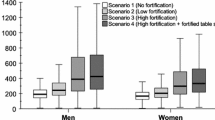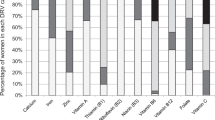Abstract
Purpose
Our aim was to estimate the prevalence of folate inadequacy (POFI) according to life stage, socio-economic status, and geographical regions after the mandatory fortification of wheat and maize flour in Brazil.
Methods
This was a population-based study. Data from two non-consecutive food records from the National Dietary Survey/Household Budget Survey 2008–2009 were used to estimate the usual dietary folate intake in µg dietary folate equivalents (DFEs). The National Cancer Institute method was used to account for within-person variance and the Estimated Average Requirement (EAR) cut-point method was used to calculate the POFI. The survey included 32,749 individuals, 15,700 males and 17,049 females, over 10 years old. Pregnant women, lactating women, and individuals with unreliable energy intake data were excluded.
Results
Overall POFI was 31.5% and mean dietary folate intake was 411.1 µg DFE. The lowest POFI occurred in the youngest age group of 10–13 years in both sexes, while the highest POFI was observed in the group ≥ 71 years. In women of childbearing age, POFI was around 32%. The lowest income strata had the highest POFI. The most developed regions (South and Southeast) had the lowest POFI compared to less developed regions.
Conclusions
Our data show that folate inadequacy is still prevalent in Brazil mainly in low-income groups and less developed regions. Actions need to be taken to ensure that women of childbearing age, who presented a high prevalence of inadequate folate intake, achieve the recommended daily intake of 400 µg DFEs.

Similar content being viewed by others
References
Tamura T, Picciano MF (2006) Folate and human reproduction. Am J Clin Nutr 83:993–1016
No authors listed (1991) Prevention of neural tube defects: results of the Medical Research Council Vitamin Study. MRC Vitamin Study Research Group. Lancet 338:131–137
Czeizel AE, Dudás I (1992) Prevention of the first occurrence of neural-tube defects by periconceptional vitamin supplementation. N Engl J Med 327:1832–1835
Werler MM, Shapiro S, Mitchell AA (1993) Periconceptional folic acid exposure and risk of occurrent neural tube defects. JAMA 269:1257–1261
Shaw GM, Schaffer D, Velie EM et al (1995) Periconceptional vitamin use, dietary folate, and the occurrence of neural tube defects. Epidemiology 6:219–226
Khoury MJ, Shaw GM, Moore CA et al (1996) Does periconceptional multivitamin use reduce the risk of neural tube defects associated with other birth defects? Data from two population-based case-control studies. Am J Med Genet 61:30–36
Food and Drug Administration (1996) Food standards: amendment of standards of identity for enriched grain products to require addition of folic acid. Fed Regist 61:8781–8797
Flour Fortification Initiative (2019) Global progress of industrially milled cereal grains. http://www.ffinetwork.org/global_progress/. Accessed Feb 12
Rosenthal J, Casas J, Taren D et al (2014) Neural tube defects in Latin America and the impact of fortification: a literature review. Public Health Nutr 17:537–550
International Clearinghouse for Birth Defects Monitoring Systems. International Centre for Birth Defects,WHO Human Genetics Programme & European Registration of Congenital Anomalies (2003) World atlas for birth defects/International Centre for birth defects of the international clearinghouse for birth defects monitoring systems, 2nd edn. World Health Organization, Geneva
Santos LMP, Lecca RCR, Cortez-Escalante JJ, Sanchez MN, Rodrigues HG (2016) Prevention of neural tube defects by the fortification of flour with folic acid: a population-based retrospective study in Brazil. Bull World Health Organ 94:22–29
Brasil. Agência Nacional de Vigilância Sanitária. Aprova o Regulamento Técnico para a Fortificação das Farinhas de Trigo e das Farinhas de Milho com Ferro e Ácido Fólico. Diário Oficial da União, Poder Executivo; Brasília: 2002. Resolução RDC no 344
The Prevention of Neural Tube Defects with Folic Acid (1999) Pan American Health Organization/Word Health Organization, Division of Health Promotion and Protection, Food and Nutrition Program. Centers for Disease Control and Prevention, Birth Defects and Pediatric Genetics—CDC
Brasil. Agência Nacional de Vigilância Sanitária. Aprova o Regulamento Técnico para a Fortificação das Farinhas de Trigo e das Farinhas de Milho com Ferro e Ácido Fólico. Diário Oficial da União, Poder Executivo; Brasília: 2017. Resolução RDC no 150
Mason JB, Dickstein A, Jacques PF et al (2007) A temporal association between folic acid fortification and an increase in colorectal cancer rates may be illuminating important biological principles: a hypothesis. Cancer Epidemiol Biomark Prev 16:1325–1329
Hirsch S, Sanchez H, Albala C et al (2009) Colon cancer in Chile before and after the start of the flour fortification program with folic acid. Eur J Gastroenterol Hepatol 21:436–439
Morris MS, Selhub J, Jacques PF (2012) Vitamin B-12 and folate status in relation to decline in scores on the mini-mental state examination in the Framingham Heart Study. J Am Geriatr Soc 60:1457–1464
Morris MC, Evans DA, Bienias JL et al (2005) Dietary folate and vitamin B12 intake and cognitive decline among community-dwelling older persons. Arch Neurol 62:641–645
Field MS, Stover PJ (2017) Safety of folic acid. Ann N Y Acad Sci 1414:59–71
Steluti J, Reginaldo C, Selhub J, Paul L, Fisberg RM, Marchioni DM (2018) Presence of circulating folic acid in plasma and its relation with dietary intake, vitamin B complex concentrations and genetic variants. Eur J Nutr. https://doi.org/10.1007/s00394-018-1852-5
Palchetti CZ, Paniz C, de Carli E et al (2017) Association between serum unmetabolized folic acid concentrations and folic acid from fortified foods. J Am Coll Nutr 36:572–578
Pfeiffer CM, Sternberg MR, Fazili Z et al (2015) Unmetabolized folic acid is detected in nearly all serum samples from US children, adolescents, and adults. J Nutr 145(3):520–531
Yetley EA, Rader JI (2004) Modeling the level of fortification and post-fortification assessments: US experience. Nutr Rev 62:S50–S59
Rader JI, Yetley EA (2002) Nationwide folate fortification has complex ramifications and requires careful monitoring over time. Arch Intern Med 162:608–609
Steluti J, Selhub J, Paul L, Reginaldo C, Fisberg RM, Marchioni DML (2017) An overview of folate status in a population-based study from São Paulo, Brazil and the potential impact of 10 years of national folic acid fortification policy. Eur J Clin Nutr 71(10):1173–1178
Brazilian Institute of Geography and Statistics (2011) Family Budget Survey, 2008–2009. Análise do Consumo Alimentar Pessoal no Brasil. Rio de Janeiro: IBGE. https://ww2.ibge.gov.br/home/estatistica/populacao/condicaodevida/pof/2008_2009_analise_consumo/. Accessed Dec 2011
University of Minnesota (2003) Nutrition Coordinating Center. Nutrition data system for research—NDSR. Minneapolis, USA. http://www.ncc.umn.edu/products/ndsr.html. Acessed July 2011
Moshfegh A, Goldman J, Jaspreet A et al (2009) What we eat in América. NHANES 2005–2006. US Department od Agriculture, Agriculture Research Service. USDA_MyPyramid Equivalents Database for USDA survey food codes. 1994–2002 Version 1. US Dept of Agriculture Agricultural Research Service; 2006. http://www.ars.usda.gov/ba/bhnrc/fsrg. Accessed April 2011
Food and Drug Administration (1996) Food standards: amendment of standards of identity for enriched grain products to require addition of folic acid. Final Rule. 21 CFR Parts 136, 137, and 139. Fed Regist 61:8781–8789
Institute of Medicine, National Academy of Sciences (1998) Dietary reference intakes for thiamin, riboflavin, niacin, vitamin B6, folate, vitamin B12, pantothenic acid, biotin and choline. National Academy Press, Washington
Carriquiry AL (1999) Assessing the prevalence of nutrient inadequacy. Public Health Nutr 2:23–34
Tooze JA, Midthune D, Dodd KW et al (2006) A new statistical method for estimating the usual intake of episodically consumed foods with application to their distribution. J Am Diet Assoc 106:1575–1587
Korn EL, Graubard BI (1999) Analysis of health surveys. Wiley, New York
Victora CG, Barreto ML, do Carmo Leal M, Lancet Brazil Series Working Group et al (2011) Health conditions and health-policy innovations in Brazil: the way forward. Lancet 377:2042–2053
Malta DC, Andrade SSCA, Stopa SR et al (2015) Brazilian lifestyles: National Health Survey results, 2013 Brazilian lifestyles: National Health Survey results, 2013. Epidemiol Serv Saúde 24:217–226
Marchioni DML, Verly-Jr E, Steluti J et al (2013) Folic acid intake before and after mandatory fortification: a population-based study in São Paulo, Brazil. Cad Saúde Pública 29:2083–2092
Vitolo MR, Canal Q, Campagnolo PDB et al (2006) Fatores associados ao risco de ingestão insuficiente de folato entre adolescentes. J Pediatr (Rio J.) 82:121–126
Bailey RL, Dodd KW, Gahche JJ et al (2010) Total folate and folic acid intake from foods and dietary supplements in the United States: 2003–2006. Am J Clin Nutr 91:231–237
Moshfegh A, Goldman J, Cleveland L et al (2005) What we eat in America, NHANES 2001–2002: usual nutrient intakes from food compared to dietary reference intakes. United States Department of Agriculture. Agricultural Research Service, Washington
Shakur YA, Garriguet D, Corey P et al (2010) Folic acid fortification above mandated levels results in a low prevalence of folate inadequacy among Canadians. Am J Clin Nutr 92:818–825
Al-Tahan J, González-Gross M, Pietrzik K (2006) B-vitamin status and intake in European adolescents. A review of the literature. Nutr Hosp 21:452–465
Park JY, Nicolas G, Freisling H et al (2012) Comparison of standardised dietary folate intake across ten countries participating in the European Prospective Investigation into Cancer and Nutrition. Br J Nutr 108:552–569
Yang Q, Cogswell ME, Hamner HC et al (2010) Folic acid source, usual intake, and folate and vitamin B-12 status in US adults: National Health and Nutrition Examination Survey (NHANES) 2003–2006. Am J Clin Nutr 91:64–72
Souza AM, Pereira RA, Yokoo EM et al (2013) Most consumed foods in Brazil: National Dietary Survey 2008–2009. Rev Saúde Pública 47:190s–199s
Cordero AM, Crider KS, Rogers LM et al (2015) Optimal serum and red blood cell folate concentrations in women of reproductive age for prevention of neural tube defects: World Health Organization guidelines. MMWR Morb Mortal Wkly Rep 64:421–423
Brasil. Ministério da Saúde (2013) Programa Nacional de Suplementação de Ferro, Manual de Condutas Gerais. Ministério da Saúde, Brasilia
de Benoist B (2008) Conclusions of a WHO Technical Consultation on folate and vitamin B12 deficiencies. Food Nutr Bull 29:S238–S244
Sedgh G, Singh S, Hussain R (2014) Intended and unintended pregnancies worldwide in 2012 and recent trends. Stud Fam Plann 45:301–314
Smith AD, Kim YI, Refsum H (2008) Is folic acid good for everyone? Am J Clin Nutr 87:517–533
Hamner HC, Tinker SC, Berry RJ, Mulinare J (2013) Modeling fortification of corn masa flour with folic acid: the potential impact on exceeding the tolerable upper intake level for folic acid, NHANES 2001–2008. Food Nutr Res. https://doi.org/10.3402/fnr.v57i0.19146
Brunacio KH, Verly-Jr E, Galvão Cesar CL et al (2013) Use of dietary supplements among inhabitants of the city of São Paulo, Brazil. Cad Saúde Pública 29:1467–1472
Funding
The study analyzed secondary data from the survey NDS/HSB 2008–2009 (IBGE), which was funded by the Brazilian Ministry of Health. This study was financed in part by the Coordenação de Aperfeiçoamento de Pessoal de Nível Superior—Brasil (CAPES)—Finance Code 001. C.Z.P. is supported by a grantship from CAPES.
Author information
Authors and Affiliations
Contributions
CZP, EVJ, JS drafted the manuscript and analyzed the data. EVJ assisted with statistical analyses, CZP, EVJ, JS, DMM interpreted the data and provided critical feedback. RS, RAP, DMM designed the research and were involved in all aspects of the manuscript from analyses to writing. All authors read and approved the final manuscript.
Corresponding author
Ethics declarations
Conflict of interest
On behalf of all authors, the corresponding author states that there is no conflict of interest.
Ethical standards disclosure
This study was conducted according to the guidelines laid down in the Declaration of Helsinki and all procedures involving research study participants were approved by the ethics committee of the Institute of Social Medicine of State University of Rio de Janeiro (CAAE 0011.0.259.000-11). All data were obtained from secondary sources and available publicly. Written informed consent was obtained from all subjects/patients.
Rights and permissions
About this article
Cite this article
Palchetti, C.Z., Steluti, J., Verly, E. et al. Prevalence of inadequate intake of folate after mandatory fortification: results from the first National Dietary Survey in Brazil. Eur J Nutr 59, 2793–2803 (2020). https://doi.org/10.1007/s00394-019-02127-w
Received:
Accepted:
Published:
Issue Date:
DOI: https://doi.org/10.1007/s00394-019-02127-w




